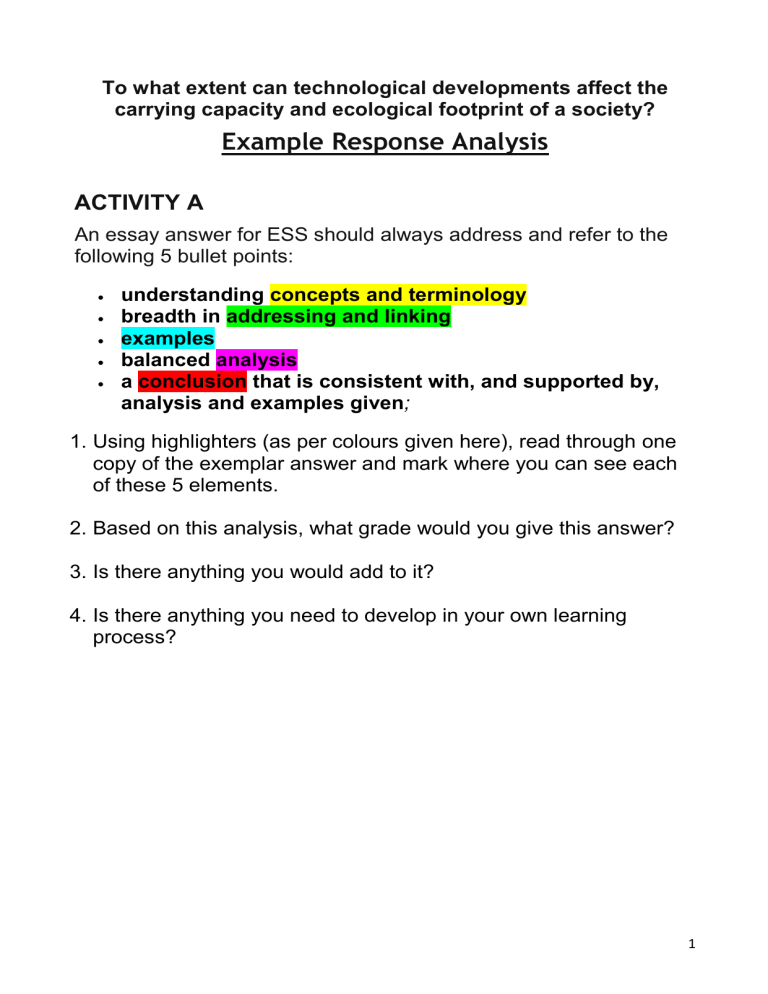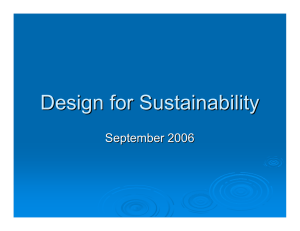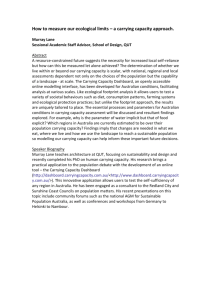Environmental Studies IB ESS exemplar essay question answer activity
advertisement

To what extent can technological developments affect the carrying capacity and ecological footprint of a society? Example Response Analysis ACTIVITY A An essay answer for ESS should always address and refer to the following 5 bullet points: understanding concepts and terminology breadth in addressing and linking examples balanced analysis a conclusion that is consistent with, and supported by, analysis and examples given; 1. Using highlighters (as per colours given here), read through one copy of the exemplar answer and mark where you can see each of these 5 elements. 2. Based on this analysis, what grade would you give this answer? 3. Is there anything you would add to it? 4. Is there anything you need to develop in your own learning process? 1 ACTIVITY B Essay assessment is aligned with the following grid. 1. Analyse the grid. Each mark boundary has 6 bullet points. What is the pattern of these bullet points as you move down the grid? 2. How do these bullet points link to the highlighting exercise you have just completed? 3. Using the grid, which grade boundary would you place the answer in? Use highlighters on a second copy of the answer to show where in the grid different parts of the answer fit. Choose a colour for each grading boundary. 4. What feedback and advice would you give the student who wrote this? ACTIVITY C What have you learnt from this process? How will you improve your essay answers? How important is the plan? How could you use the criteria in ACTIVITY A to help you plan an answer? 2 The Exemplar Answer – what grade would you give and why? This text is taken from the inthinking resources page. The carrying capacity of a society is the maximum number of people that can be sustainably supported by a given area, e.g. how many people can be sustained by the land of Australia. For other species this would normally mean that all the resources required to support this population would be produced within the confines of the area. Humans, however, have proved to be ingenious, and import large quantities of resources to increase the theoretical carrying capacity of an area. Japan is an example where they have used technology to extend their carrying capacity. Japan is a very mountainous country without large amounts of forest remaining. As the Japanese appreciate wood buildings culturally then they import large amounts of timber to support this demand. Japan also does not have fossil fuel or uranium deposits and so imports large amounts of energy resources to support demand. The Sahel on the other hand is a poor region with little ability to import resources to support an increase in carrying capacity. If the Sahel was able to use technology such as drilling into fossil aquifers below the region, then this would temporarily support a rise in the carrying capacity of the region. In the long term, however, the use of technology can lead to a decline in the carrying capacity of a society. Throughout human history there are examples of the crash of societies associated with environmental degradation. This could be argued to be through the overuse / poor use of technology. Agricultural regions can decline in fertility with the overuse of modern agricultural techniques such as inorganic fertilisers, heavy farm machinery and pesticides. The dust bowl in America was due to a combination of drought in areas that were ploughed and not suitable for this purpose. There is also mounting evidence that modern farming techniques, heavily reliant on inorganic fertilisers, monocropping and mechanization leading to a decline in the ability of soil to store carbon, have a biodiverse microflora, and maintain high yields of crops. On the other hand Esther Boserup found that when societies’ populations increased to their limits, technological innovations led to an increase in carrying capacity of that region. An ecological footprint is the reciprocal of a carrying capacity. Whereas the carrying capacity is for a given area, the ecological footprint is the amount of land and water needed to provide all the resources for a given society and assimilate all the waste. It is therefore a more useful measure of sustainability. If a population is using more land and water than is available then it is not sustainable. Different parts of the world, biomes, with differing biocapacities due to the amount of insolation and precipitation received, will be more or less productive and better or less able to assimilate waste. 3 Technology can increase the ecological footprint of a society. If that society increases its use of non-renewable resources, particularly fossil fuels then the EF will increase as the amount of land required to assimilate that waste (CO2) will also increase. I would argue that the use of fossil fuels will always increase a society’s EF and is not compatible with a sustainability goal. Alternatively, the development of technology which supports reduced use of fossil fuels, reduced waste production and increased efficiency will reduce the ecological footprint of a society. There is a push towards a circular economy. This would mean that items are designed for longevity, re-useability, recyclability and easy changing of components without the necessity for replacing the whole device. An example of this would be Siemens which has started producing washing machines which you buy but can upcycle as many times as you like. There is no redundancy in the design of the machines. The company takes back the machine, upgrades parts and passes it along to another customer. Technology used to increase the efficiency of energy production will reduce the ecological footprint. Alternative energy sources, such as solar, wind, geothermal energy can also help reduce an EF. Switzerland is pushing a policy of a 2000 W Society, whereby each citizen has a budget of 2000 W. Education measures are put in place to encourage reduced and more efficient energy use. It might also be argued that many factors other than technology impact the EF of a country. Changes in diet, towards a more meat heavy diet, as is happening in China, can have a far greater impact on the EF of the country than other factors, such as the use of private transport. It can’t be argued that technology when comparing a LEDC such as Ethiopia, and an MEDC such as Switzerland do not contribute to an increase in the EF of that country, however, if we think of the IPAT formula which says that the Impact of a Society is equal to its population x affluence x technology then we do see a peak in the EF followed by a decline as countries start to implement technology that will focus on reducing the EF. 4 The Exemplar Answer – what grade would you give and why? The carrying capacity of a society is the maximum number of people that can be sustainably supported by a given area, e.g. how many people can be sustained by the land of Australia. For other species this would normally mean that all the resources required to support this population would be produced within the confines of the area. Humans, however, have proved to be ingenious, and import large quantities of resources to increase the theoretical carrying capacity of an area. Japan is an example where they have used technology to extend their carrying capacity. Japan is a very mountainous country without large amounts of forest remaining. As the Japanese appreciate wood buildings culturally then they import large amounts of timber to support this demand. Japan also does not have fossil fuel or uranium deposits and so imports large amounts of energy resources to support demand. The Sahel on the other hand is a poor region with little ability to import resources to support an increase in carrying capacity. If the Sahel was able to use technology such as drilling into fossil aquifers below the region, then this would temporarily support a rise in the carrying capacity of the region. In the long term, however, the use of technology can lead to a decline in the carrying capacity of a society. Throughout human history there are examples of the crash of societies associated with environmental degradation. This could be argued to be through the overuse / poor use of technology. Agricultural regions can decline in fertility with the overuse of modern agricultural techniques such as inorganic fertilisers, heavy farm machinery and pesticides. The dust bowl in America was due to a combination of drought in areas that were ploughed and not suitable for this purpose. There is also mounting evidence that modern farming techniques, heavily reliant on inorganic fertilisers, monocropping and mechanization leading to a decline in the ability of soil to store carbon, have a biodiverse microflora, and maintain high yields of crops. On the other hand Esther Boserup found that when societies’ populations increased to their limits, technological innovations led to an increase in carrying capacity of that region. An ecological footprint is the reciprocal of a carrying capacity. Whereas the carrying capacity is for a given area, the ecological footprint is the amount of land and water needed to provide all the resources for a given society and assimilate all the waste. It is therefore a more useful measure of sustainability. If a population is using more land and water than is available then it is not sustainable. Different parts of the world, biomes, with differing biocapacities due to the amount of insolation and precipitation received, will be more or less productive and better or less able to assimilate waste. Technology can increase the ecological footprint of a society. If that society increases its use of non-renewable resources, particularly fossil fuels then the 5 EF will increase as the amount of land required to assimilate that waste (CO2) will also increase. I would argue that the use of fossil fuels will always increase a society’s EF and is not compatible with a sustainability goal. Alternatively, the development of technology which supports reduced use of fossil fuels, reduced waste production and increased efficiency will reduce the ecological footprint of a society. There is a push towards a circular economy. This would mean that items are designed for longevity, re-useability, recyclability and easy changing of components without the necessity for replacing the whole device. An example of this would be Siemens which has started producing washing machines which you buy but can upcycle as many times as you like. There is no redundancy in the design of the machines. The company takes back the machine, upgrades parts and passes it along to another customer. Technology used to increase the efficiency of energy production will reduce the ecological footprint. Alternative energy sources, such as solar, wind, geothermal energy can also help reduce an EF. Switzerland is pushing a policy of a 2000 W Society, whereby each citizen has a budget of 2000 W. Education measures are put in place to encourage reduced and more efficient energy use. It might also be argued that many factors other than technology impact the EF of a country. Changes in diet, towards a more meat heavy diet, as is happening in China, can have a far greater impact on the EF of the country than other factors, such as the use of private transport. It can’t be argued that technology when comparing a LEDC such as Ethiopia, and an MEDC such as Switzerland do not contribute to an increase in the EF of that country, however, if we think of the IPAT formula which says that the Impact of a Society is equal to its population x affluence x technology then we do see a peak in the EF followed by a decline as countries start to implement technology that will focus on reducing the EF. 6




